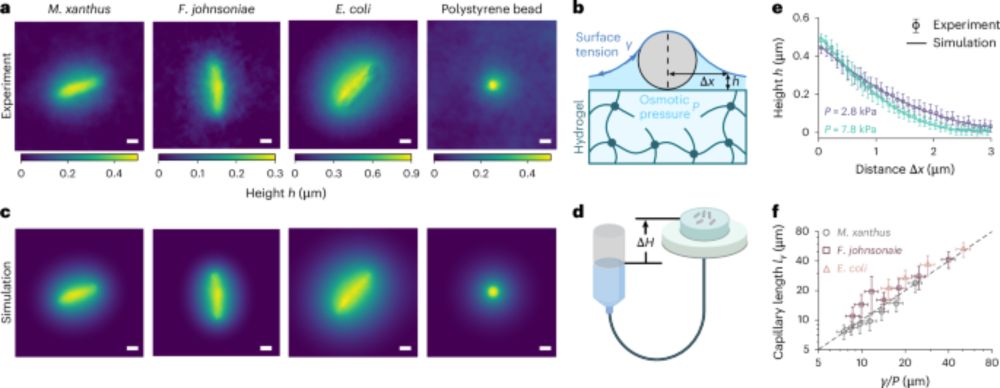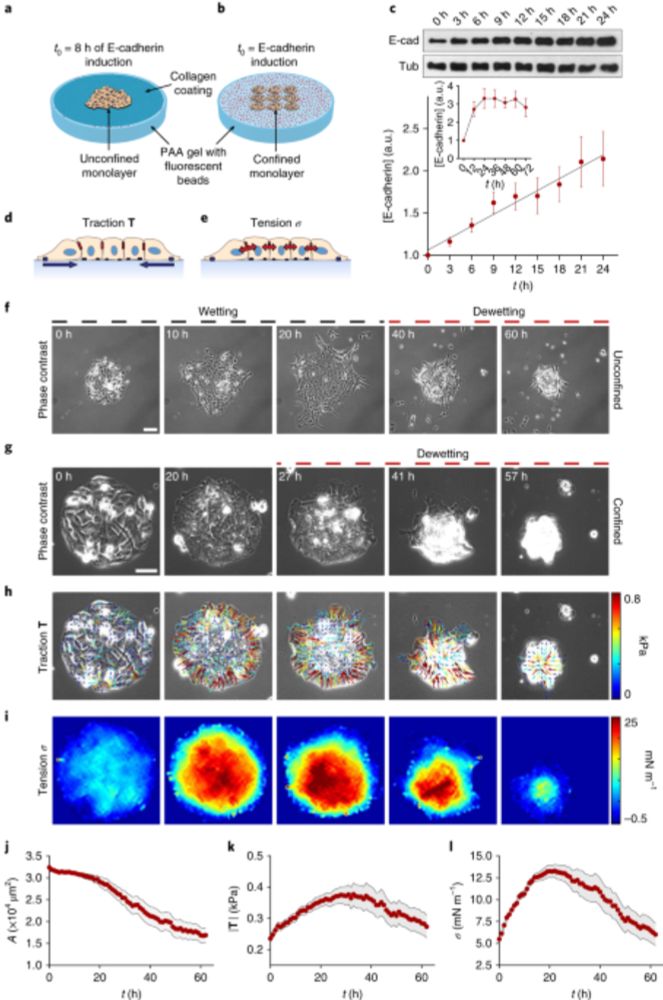Escolta en nou capítol de La utilitat del coneixement inútil!
Quàntica, ordinadors i espanta sogres!!! 🎉🥳
28.10.2025 06:59 — 👍 2 🔁 2 💬 0 📌 0
🤔 Can tissue patterning & tumor heterogeneity emerge in a self-organized way?
We show that self-organized mechanical stress & density gradients pattern tumors in vitro & in vivo, and this behavior is quantitatively predicted by a mechano-chemical active fluid model!
Check out Carlos' thread ⬇️
16.10.2025 22:40 — 👍 17 🔁 3 💬 0 📌 0
Awesome work! :)
17.10.2025 09:54 — 👍 2 🔁 0 💬 1 📌 0
1/ 🎉Excited to share our new preprint @vignjeviclab.bsky.social @davidbrueckner.bsky.social :
"Self-organization of tumor heterogeneity and plasticity"
biorxiv.org/content/10.1...
Tumor heterogeneity and plasticity drive metastasis and relapse. How is tumor patterning coordinated?
A thread👇
16.10.2025 21:54 — 👍 64 🔁 28 💬 6 📌 2
Spotify – Web Player
🛰️ Sabies que fas servir la teoria de la relativitat cada cop que treus el GPS?
Mira el 4t capítol de La utilitat del coneixement inútil per veure com li peta el cap a la @soctastaolletes.bsky.social 🤯
Amb un ajut @fcri.bsky.social
open.spotify.com/episode/4lza...
16.10.2025 06:08 — 👍 3 🔁 3 💬 0 📌 0
Theory and data analysis work done by postdoc MJ Franco-Oñate in my group.
02.10.2025 08:04 — 👍 1 🔁 0 💬 0 📌 0
New job, new preprint! We found that embryo implantation can be understood as active wetting! Embryos from older mothers have trouble implanting because they are too contractile and viscous. Check out the wonderful thread (and movies!) by @katecavanaugh.bsky.social.
www.biorxiv.org/content/10.1...
02.10.2025 08:04 — 👍 18 🔁 6 💬 1 📌 0

Excited to be back in Barcelona @ub.edu to start a new chapter!
01.10.2025 07:10 — 👍 21 🔁 0 💬 2 📌 0

Warm goodbye to Dresden's @mpipks.bsky.social, my scientific home for the past 4 years. It's been amazing to start my group here! Thanks to the Max Planck Society, group members and everyone at the institute! Looking forward to the new chapter in Barcelona @ub.edu
21.09.2025 13:57 — 👍 54 🔁 1 💬 3 📌 1

Tipsy bats and perfect pasta: Ig Nobels celebrate ‘improbable’ research
The annual awards are a celebration of weird but thought-provoking science.
IG Nobel Prize in #Physics 2025 to @mpipks.bsky.social researchers for elucidating the phase behaviour of cacio e pepe sauce. The work highlights how physics can also be applied to solve daily-life problems!
nature.com/articles/d41586-025-03045-0
19.09.2025 13:11 — 👍 45 🔁 16 💬 1 📌 5
Truly happy to see that our Italian colleagues @mpipks.bsky.social won the IgNobel Prize for figuring out that the Cacio e Pepe sauce can easily phase separate and become clumpy! Very well deserved! Congrats to the team! 😀
19.09.2025 14:42 — 👍 13 🔁 0 💬 0 📌 0

Check our new preprint on active surface simulations of amoeboid migration! We show how this mode of migration can be mechanically guided by gradients in friction, viscosity, pressure, or confinement, and even by nearby cells. Work led by Hanna Gertack and Sebastian Aland.
arxiv.org/abs/2509.11801
19.09.2025 09:37 — 👍 10 🔁 1 💬 1 📌 0
YouTube video by La Dimoni de Maxwell
L'àtom com balla!
🤔Què tenen en comú l’Ou com balla i un àtom?
🎙️El Lluís Torner, fundador de l’ICFO ens ho explica!
👉 Escolta el 2n capítol de La utilitat del coneixement inútil!
Amb el suport d’un Ajut FCRI 2025 @fcri.bsky.social
@soctastaolletes.bsky.social
youtube.com/shorts/Al5mY...
18.09.2025 13:10 — 👍 4 🔁 4 💬 0 📌 0
Very honored to receive this prize from the Spanish Physical Society! Thanks a lot to all my collaborators, who make this possible!
17.09.2025 16:21 — 👍 17 🔁 2 💬 3 📌 0

Bacteria are surrounded by water! New work @natphys.nature.com by @ricardalert.bsky.social @mpipks.bsky.social & collaborators @ Princeton University shows that water capillary forces organise bacterial colonies into gas, nematic streams, and droplet states.
nature.com/articles/s41567-025-02965-y
16.09.2025 18:03 — 👍 22 🔁 9 💬 2 📌 0
Congrats, David! Super! :)
05.09.2025 08:18 — 👍 1 🔁 0 💬 1 📌 0
Our paper about active crystals is now out @softmatter.rsc.org! During the revisions, we added a section about triangular lattices, on which the turn-towards or turn-away interactions can be frustrated. Check it out, and see the post below!
pubs.rsc.org/en/content/a...
bsky.app/profile/rica...
27.08.2025 14:36 — 👍 17 🔁 2 💬 0 📌 0
YouTube video by La Dimoni de Maxwell
Gelat de vidre
Has intentat ma fer un gelat casolà i no ha sortit tan cremós com esperaves? T'han quedat uns cristalls que et trinxen les dents? 🍦☀️
A la @soctastaolletes.bsky.social i a mi ens ha passat, però tenim la solució...
youtube.com/shorts/hAXjP...
24.08.2025 10:16 — 👍 5 🔁 4 💬 0 📌 0
Water menisci are a key player in bacterial colonies. Capillary forces are strong and relevant at the bacterial scale! If you know of other roles of water capillary forces in collective cell dynamics, please let me know!
02.08.2025 14:59 — 👍 2 🔁 0 💬 0 📌 0
n these streams, bacteria are densely packed but can still freely move past one another. Capillary forces allow bacteria to pack densely without cell-cell adhesion, avoiding jamming.
02.08.2025 14:59 — 👍 3 🔁 0 💬 1 📌 0
Capillary forces organize gliding bacteria into different phases. In the movie, menisci are initially wide but weak, and bacteria form a gas. When water is made less available, capillary forces become strong and organize the colony into nematic streams. Watch until the end!
02.08.2025 14:59 — 👍 1 🔁 0 💬 1 📌 0

Capillary attraction also makes bacteria arrange side by side after dividing.
02.08.2025 14:59 — 👍 0 🔁 0 💬 1 📌 0
When their menisci touch, bacterial cells experience capillary attraction. Check out the video! This attractive interaction promotes bacterial aggregation.
02.08.2025 14:59 — 👍 5 🔁 0 💬 2 📌 0

Matt and Josh developed an apparatus to control water availability, which directly impacts the pressure, and hence the width of the menisci.
02.08.2025 14:59 — 👍 0 🔁 0 💬 1 📌 0

On hydrated environments, like soil, textiles, and hydrogels, bacteria are surrounded by a meniscus of water. We fit the meniscus profile with a model based on surface tension and the osmotic pressure of extracting water from the substrate.
02.08.2025 14:59 — 👍 1 🔁 0 💬 1 📌 0

Capillary interactions drive the self-organization of bacterial colonies - Nature Physics
Bacteria tend to live in thin layers of water on surfaces. Now the capillary forces in these layers are shown to help organize the bacteria into dense packs.
Dreaming of a swimming pool? Bacteria are surrounded by water! Water capillary forces organize bacterial colonies into gas, nematic streams, or droplet states. New paper @natphys.nature.com led by Matt Black and Chenyi Fei, with Ned Wingreen and Josh Shaevitz!
www.nature.com/articles/s41...
02.08.2025 14:59 — 👍 56 🔁 13 💬 3 📌 1
A Catalunya teníem, a part dels científics, un gran professional de la curiositat: el Tomàtic! 🍅 Què se n'ha fet d'un personatge així a l'era del ChatGPT?
02.07.2025 18:06 — 👍 1 🔁 0 💬 1 📌 0
Curiositat científica: Quant duraria la vida a la terra si en desconnectéssim el camp magnètic?
02.07.2025 18:06 — 👍 1 🔁 0 💬 0 📌 0
PhD student @mpi-cbg.de in the Veenvliet group @jesseveenvliet.bsky.social and at Physics of Life TU Dresden in the Campàs group @campaslab.bsky.social. All about understanding self-organizing and developing matter #biophysics #stembryos#embryos
We're the Crick, a biomedical research lab in London working to figure out how life works.
Home to more than 2,000 scientists and a free public exhibition space.
https://www.crick.ac.uk/
Junior Research Group Leader in Cell Biology of the Intestine and Intestinal Disease - University of Stuttgart/University of Tübingen
Department and School of Medicine and Life Sciences at @upf.edu. Located at the @prbb.org & member of #SOMM_alliance
www.upf.edu/biomed
Physics, philosophy, complexity. @jhuartssciences.bsky.social & @sfiscience.bsky.social. Host, #MindscapePodcast. Married to @jenlucpiquant.bsky.social.
Latest books: The Biggest Ideas in the Universe.
https://preposterousuniverse.com/
Developmental biology fascinated about the mane (sur)faces/phases of epithelial morphogenesis: from mechanics to evolution.
https://www.bdr.riken.jp/en/research/labs/wang-yc/index.html
Our lab unravels the mechanobiology and cellbiology of immune cells, their migration & cytoskeleton, their organelles, and their cell-matrix interplay using #imaging, #screening, and #bioengineering
@bmc-lmu.bsky.social
www.renkawitz-lab.com
Physicist having a go at biology, EMBO postdoctoral fellow @UCL in the Mao group, @EMBL alumna
Dynamics of Complex Living Systems Young Investigator Group Leader at CASUS-HZDR. Görlitz, Germany
HSRU postdoctoral fellow
Pew Latin American fellow
Development & Stem cell bio
#ucsc 🌈 UNMSM 🇵🇪 UNSAM 🇦🇷
Biophysics PhD at @mpipks.bsky.social and @mpi-cbg.de
Theoretical Biophysics, PostDoc @Biozentrum Basel, previous @EMBL Heidelberg
Topics: Mechanochemical feedbacks | Self-organization and pattern formation | Information Theory
Group Leader Mathematical and Physical Biology Lab @TheCrick and @UCL Physics. Interested in how size, shape and patterns develop and evolve; https://www.hadjivasilioulab.com/.
Applied Mathematician curious about all things FLUID 💦 and BIO 🦠.
Els Koffeman Fellow @ University of Amsterdam, Institute of Physics
Postdoc @fluidlab, University of Amsterdam
PhD @LPENS
Biophysics of photosynthetic micro-organisms
Biophysicist | genotype-phenotype maps, fitness landscapes and evolution | Independent Fellow leading a group at @barcelonacollaboratorium.com @crg.eu
Biological soft matter physics. Postdoc @ MPIPKS. Ph.D @ UT Austin. Slowly activating here
Cell biologist driven by a passion for cell division
















